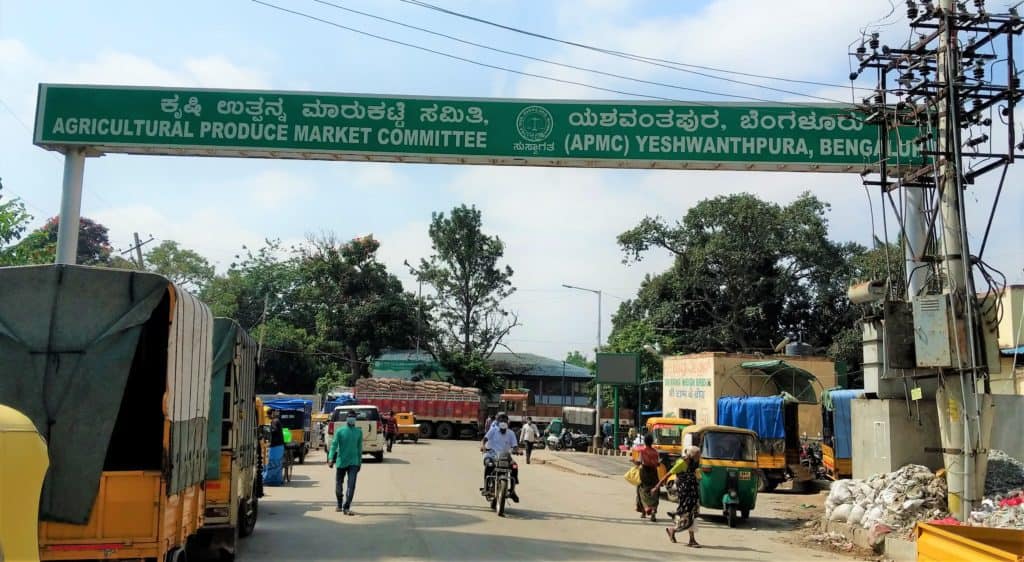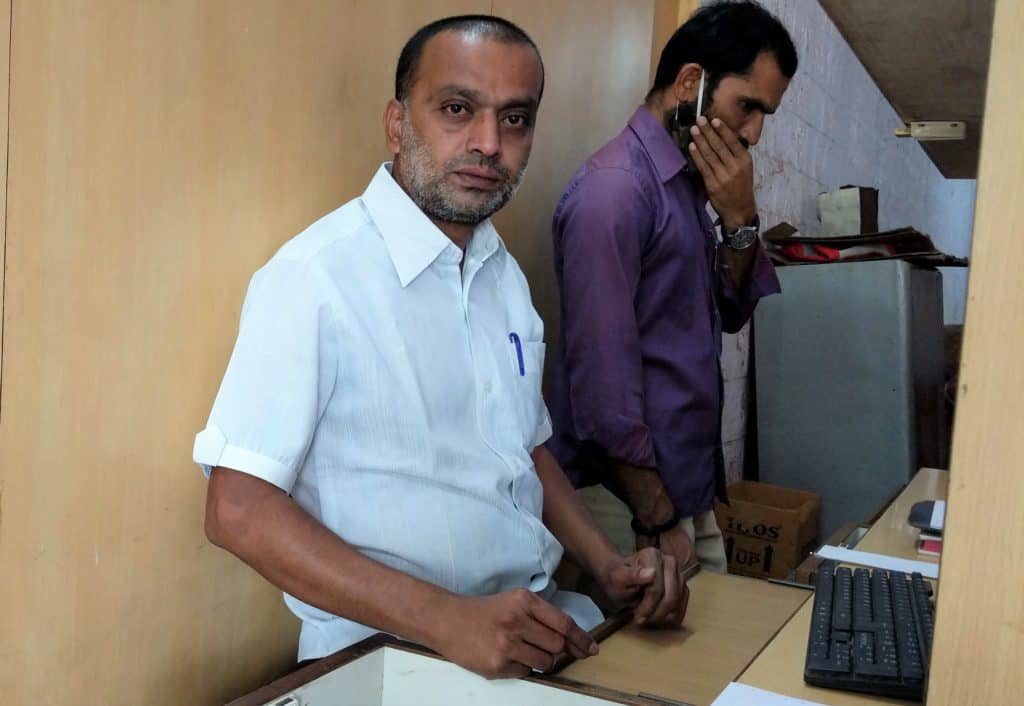
In September end, M Dasappa loaded the onions harvested on three acres of his farm in Seegehatti in Chitradurga district, and headed towards the APMC yard in Yeshwanthpur in Bengaluru. There is a foreboding of disappointment in the trip this time around – he normally produces 300 quintals of onions; this time, heavy rains had led to losses and he is selling only 220 quintals.
At the APMC (Agriculture Produce Marketing Committee) yard, the truck unloads the bags of gleaming onions. Byaravishwara Swamy, a commission agent whose family runs several shops in the yard, inspects the onions. The quality has dipped because of the rains, he comments. But he assures Dasappa there will be buyers.
At 9 am, the auction starts and open bids are heard. Within a half hour, Dasappa’s stock is sold to a buyer from Tamil Nadu. Nearly Rs 1,500 per quintal. Swamy will adjust this amount to the advances he had given to Dasappa, and pay him in cash. For some other farmers, payment is through cheque or bank transfers.
Dasappa says, “I always make calls to find out the price of onions before deciding to come to the APMC. This is an open auction and we know the prices will be fair. And Bengaluru usually has the best prices for onions in the state.”
Dasappa is among the thousands of farmers from across the state who make their way to the Yeshwanthpur APMC yard. This is the state’s largest market, and among the biggest in South India for onions.
A day after the farmer’s strike (against the Centre’s new farm laws) crippled activity in the yard, the bustle has returned. Trucks and mini goods vehicles make their way through congested streets with the frequency of bees in a hive; hamali workers (porters) load and unload 55-kg sacks; the stench of rotten onions strewn across or piled by the road pervades the air; farmers and traders, or traders and buyers, converse animatedly on rates and logistics.
Why APMCs?
Bengaluru’s APMC was established in 1955 and was designed to be a “friend” of the farmer. Before the establishment of these committees and markets, farmers sold produce in local, unregulated markets where prices for produce fluctuated wildly or where farmers were vulnerable to be cheated in price or the quantity weighed. Farmers often got low returns on produce, and consumers would end up buying at higher prices. Middlemen and traders made the bulk of the profit.
Hence regulated market yards were envisioned to house multiple traders and buyers under one roof, to ensure that competition would stabilise prices for farmers. Theoretically, consumers too would benefit from the quality check on produce by agents and buyers.

Market yards would be administered by a Committee who ensured timely payment, enforcement of fair weights, and maintenance of infrastructure needed for the sale of produce. The Committee itself doesn’t buy or sell produce; it only “facilitates” trade.
For most of modern Bengaluru’s history, it was mandatory for farmers to sell notified produce at APMCs – making it the gateway for food into the city. As laws relaxed, private markets such as Metro Cash & Carry and Safal took the role of APMC and became intermediaries between farmers and consumers.
Apart from this, the government-controlled HOPCOMS became a large centre for procurement and sales of perishable vegetables. Additionally, raitha santhes popped up across the city, allowing farmers in neighbouring districts to bring in vegetables, fruits, greens and flowers directly to consumers.
Though many farmers like Dasappa rely on APMCs, many others choose to bypass the system. Barely 35% of farmers in the state use APMCs now and the majority of produce is sold in local markets, says Dr T N Prakash Kammardi, former Chairman of Karnataka Agricultural Price Commission.
What’s traded in Bengaluru’s APMC system?
The APMC yard in Yeshwanthpur is spread over 85 acres, and over 92 commodities are traded here. Many of the buyers and sellers are from outside the city; hence the commodities traded are mostly those with longer shelf life, such as onions, potatoes, garlic, ginger, chillies, coconuts, and food grains including wheat, maize, ragi and rice. Each commodity is traded at specific places in the yard.
Additionally, some commodities are traded in the “sub-yards” of the APMC in KR Puram (perishable vegetables and flowers), Binny Mills, Anekal, Dasanapura (which was recently opened to ease congestion in Yeshwanthpur yard), among others. The Binny Mills market, for instance, handles over 1,200 tonnes of more than 40 varieties of fruits and vegetables. Unlike the Yeshwanthpur yard, the commodities in the sub-yards are mostly sold to consumers within the city.
In Yeshwanthpur yard, onions come from across the state and Maharashtra, while the buyers arrive from Tamil Nadu, Kerala, Odisha and West Bengal, says B Swamy, who is one of the 1,597 licensed commission agents here.

Commission agents act as facilitators between farmers and buyers. The peak season for onions is between August and December, during which Swamy’s shop receives more than 100 tonnes of the vegetable from districts such as Chitradurga and Gadag. “I would guess that nearly 80-90% of the onions in my shop are sold out of the city,” he says.
Potatoes can come from Hassan, Kolar and Chintamani, and even as far away as Madhya Pradesh and Uttar Pradesh, whereas their sale is in local markets as well as neighbouring states. A trader says nearly half the potatoes sold in his shop is for the local market and local food processing industries.
Onions and potatoes are the biggest agricultural produce here, making up around a third of the goods traded in the market. On average, 3,600 tonnes of onions and potatoes are brought in daily between August and October.
Additionally, 1,350 tonnes of rice, 200 tonnes of toor dal, 120 tonnes of wheat and maize arrive in the APMC daily. Locally, it is the trading of rice and pulses – which are sold here as processed goods through millers – that is important.
Nearly half the food grains come from within the state, and the rest come from Tamil Nadu, Maharashtra, Chattisgarh, Haryana and other states.
Ramesh Chandra Lahoti, President of the Bangalore Wholesale Food grains & Pulses Merchants Association, says, “The APMC in Yeshwanthpur caters to nearly three crore population in southern Karnataka, with Bengaluru being the obvious biggest market.”
How does trade happen in the Yeshwanthpur APMC yard? And why are many farmers sidestepping this system? We explore this is Part 2 of this series.
If the farmers come together to form an FPO, can the FPO aggregate the produce from its members and sell to a processor directly ? Or, FPO needs a APMC license?
What about the buyer who happens to be a trader from TN ?? He is again another middle man in the supply chain before the actual end-user consumer buys that onion ?? Infact is APMC not creating another middle man adding to burden of the consumer ??.. Pls think and asnwer …